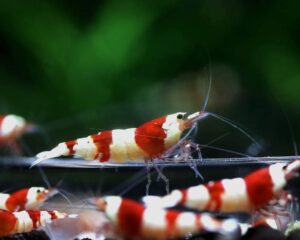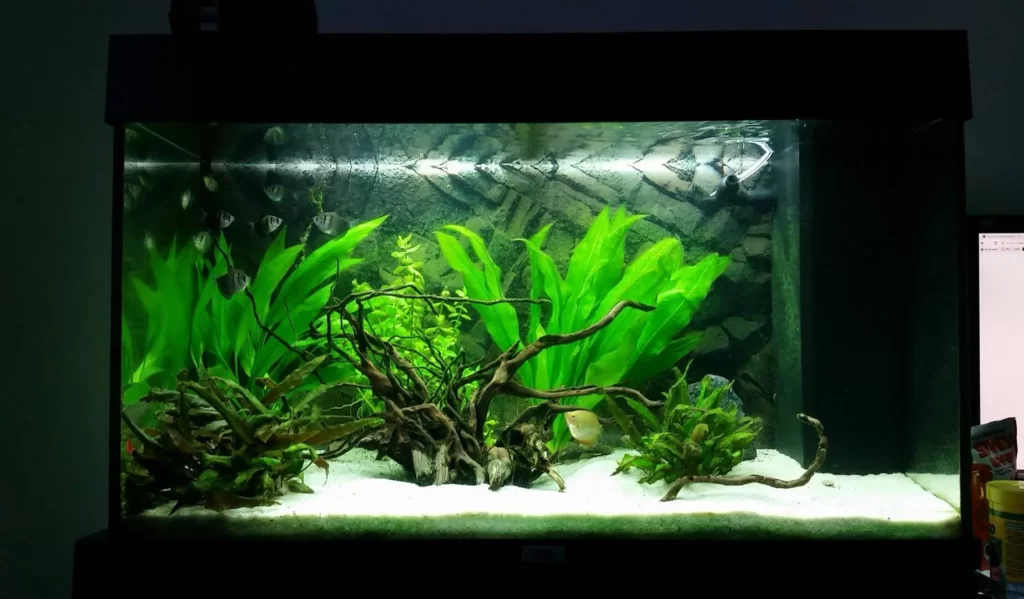
Bolivian Ram Care: Ultimate Comprehensive Guide

Writer at The Aquarium Keeper
The Bolivian Ram is an interesting cichlid, that is becoming more and more popular amongst fellow fish keepers. These fish display unique coloration patterns that make them visually appealing additions to any tank. Whether you’re a beginner or an experienced aquarist, adding Bolivian Rams to your community aquarium can bring beauty and tranquility to your underwater world.
Bolivian Ram Species Summary
If you are looking for a calm, colorful, and interactive dwarf cichlid, the Bolivian Ram is the right species for you. Compared to larger cichlids, Bolivian Rams are extremely peaceful, portray a wide range of different colors, and can get along with larger or even smaller fish in a community aquarium.

| Aspect | Information |
|---|---|
| Scientific Name | Mikrogeophagus altispinosus |
| Common Name | Bolivian Ram |
| Origin | South America |
| Rarity | Common |
| Price | $10 - $20 USD per fish |
| Care Level | Moderate |
| Water Temperature | 22°C - 28°C (72°F - 82°F) |
| pH | 6.0 - 7.5 |
| Minimum Tank Size | 30 gallons |
| Diet | Omnivore - Flakes, pellets, live or frozen foods, bloodworms, blanched vegetables |
| Temperament | Peaceful |
| Lifespan | 5 - 7 years |
| Size | 3 inches |
Temperament and General Behavior of Bolivian Rams
Before purchasing any type of aquarium fish, it is important to understand the temperament of the species, before you introduce them to your aquarium.
Calm and Non-Aggressive Towards Other Fish Species
One of the standout characteristics of Bolivian Rams is their calm and non-aggressive nature towards other fish species. Unlike some cichlids that can be territorial or aggressive, Bolivian Rams tend to be peaceful community fish. They coexist well with a variety of tank mates, making them an excellent choice for community aquariums.
Territorial Behavior During Breeding
While Bolivian Rams are generally peaceful, they do exhibit territorial behavior during breeding. This behavior is not usually harmful but rather a natural instinct for these cichlids. When preparing to breed, they may become more protective of their chosen spawning site and show aggression towards intruders who venture too close.
Shy at First, Active Over Time
When introduced to a new environment, Bolivian Rams may initially be shy and cautious. It’s not unusual for them to hide or stay close to cover until they feel comfortable in their surroundings. However, over time, as they acclimate to their tank and become familiar with their territory, they tend to become more active and confident in exploring the aquarium.
Monogamous Pairs and Parental Care
Bolivian Rams are known for forming monogamous pairs. Once a pair has formed, they will often stay together throughout their lives. This bonding creates a sense of stability within the aquarium environment.

Not only do Bolivian Rams form strong pair bonds but they also display remarkable parental care towards their offspring. Both parents actively participate in guarding the eggs during spawning and continue to protect the fry after hatching. This nurturing behavior adds an endearing touch to their overall temperament.
Bolivian Ram Appearance
Bolivian rams are one of many types of ram cichlids, that are available in the aquarium hobby. These species are truly unique when it comes to appearance. Continue reading to find out the things you should know about their appearance, that would help you successfully tell them apart from other fish.
Body Shape And Size
The body of a Bolivian Ram is oval-shaped, which gives them an elegant and streamlined look. This shape allows them to swim gracefully through the water. Their body is compact and well-proportioned, making them visually appealing in any aquarium setting.

With proper care and optimal conditions, Bolivian Rams have the potential to grow up to 3 inches in length. However, it’s important to note that individual growth rates may vary depending on various factors such as diet, water parameters, tank size, and genetics.
Color Varietes
Bolivian Rams exhibit a wide range of colors that can vary depending on their mood and environment. Their natural coloration can be described as golden yellow or grayish-brown. These interesting hues make them stand out among other fish species in the aquarium.
Bolivian rams also often have red coloration at the end of their partially transparent fins, but the intensity of the redness can vary from fish to fish. The color intensity can also depend on many factors like lighting conditions, water quality, and even the presence of other fish.
Tank Setup And Care Requirements For Bolivian Rams
To ensure the well-being of your Bolivian Rams, it is crucial to provide them with an appropriate tank setup and meet their care requirements.
Tank Size
Bolivian Rams thrive in spacious environments that allow them to swim freely. For a pair of these beautiful fish, a minimum tank capacity of 30 gallons is recommended. Providing ample space ensures that they have enough room to establish territories and exhibit their natural behaviors.
Substrate Selection
When choosing the substrate for your Bolivian Ram tank, opt for fine-grained sand or smooth gravel. These substrates mimic the sandy riverbeds found in their native habitat. Bolivian Rams have a natural inclination to dig into the substrate, so providing them with this suitable environment will keep them happy and engaged.
Tank Decorations
Creating hiding spots within the tank is essential for Bolivian Rams as it mimics their natural habitat in the Amazon basin. Decorate the tank with driftwood, rocks, caves, or plants to provide ample hiding places where they can retreat when feeling stressed or threatened.
Be sure to pick plants, that are not dependent on substrate, like column-feeding aquarium plants. From personal experience, Bolivian Rams have a tendency to uproot plants when digging around.
Lightning Conditions
Maintaining moderate lighting conditions in your Bolivian Ram tank is crucial. You can achieve this by using floating plants or dimmed lights that replicate the dappled sunlight found in their natural environment. Excessive brightness may cause stress or discomfort to these fish, so providing subdued lighting will help create a more suitable atmosphere.
Be sure to pick plants, that are not dependent on substrate, like column-feeding aquarium plants. From personal experience, Bolivian Rams have a tendency to uproot plants when digging around.
Water Parameters
Water parameters are probably the most important aspect when keeping any kind of fish. Most people get this wrong, including myself, and it can lead to various disasters in an aquarium. Keep the water temperature between 22°C – 28°C (72°F – 82°F) and pH 6.0 – 7.5 as this range of parameters closely resembles their native habitats.
Tank Setup Examples
To get a better understanding of how a Bolivian Ram tank setup should look, here are a few examples that I found on the internet. Bolivian Ram aquarium setups don’t need to follow too many rules, but there are a few things you should do right to have a beautiful tank.

In the first example, you can see a well-established Bolivian Ram aquarium with multiple pairs of these species already formed. The substrate for this tank is gravel. The types of plants in the picture are marimo moss ball, various anubias species, and these plants don’t need to be planted, which is good for Bolivian Ram tanks (they tend to uproot plants while digging).

The second photo features a little different setup from the previous one. The substrate is white sand, which is a good way to showcase aquarium fish colors. The plants I can see in this picture are the Amazon sword and the java fern which are hardy plants that don’t fully rely on substrate for nutrients.
Proper Diet And Feeding Habits
Bolivian Rams require a balanced diet to thrive in your aquarium. Here are some things you should know about their diet.
Bolivian Rams Omnivorous Nature
Bolivian Rams, like many cichlids, are omnivorous creatures. This means they eat both plant matter and small organisms found in their natural habitat. To mimic their natural diet, it’s crucial to provide them with a variety of foods.
Best Foods For Bolivian Rams
To ensure the health of your Bolivian Rams, offer them high-quality pellets or flakes specifically formulated for cichlids as their staple food. These pellets or flakes contain all the necessary nutrients to support their growth and overall well-being.
While pellets or flakes serve as the foundation of their diet, here are additional things you can feed Bolivian Rams:
- Frozen/live bloodworms
- Brine Shrimp
- Insect larvae
- Blanched vegetables
When feeding your Bolivian Rams, it’s best to offer small portions multiple times throughout the day rather than one large meal. This prevents overeating and ensures that each fish has an equal opportunity to consume its share of food.
Suitable tank mates for Bolivian Rams
If you’re looking to add some companions to your aquarium with your Bolivian Rams, there are several suitable tank mates that can coexist peacefully.
Peaceful Community Fish
It’s important to select peaceful community fish that won’t cause any harm or stress to your Rams. Some popular choices include tetras, rasboras, and gouramis. These fish have a calm temperament and will generally get along well with the Bolivian Rams.
Small Catfish Species
Another option for tank mates is small catfish species like Corydoras. These bottom-dwelling fish can peacefully coexist with Bolivian Rams as they occupy different areas of the aquarium. The Corydoras catfish are known for their playful nature and can add an interesting dynamic to the tank.
Bad Tank Mates For Bolivian Rams
It’s important to consider their compatibility with other fish. While these beautiful and peaceful cichlids can get along well with a variety of species, there are certain types of fish that may not be suitable companions.
Large and Aggressive Cichlid Species
Bolivian Rams have a peaceful nature and can easily become intimidated or even attacked by larger and more aggressive cichlid species. These dominant fish may see the Bolivian Ram as competition or a potential threat to their territory. It’s best to avoid keeping them together to prevent any harm or stress to the Bolivian Rams.
Fin-Nipping Fish
There are a lot of fin-nipping species you should avoid, and from personal experience, tiger barbs are notorious for their fin-nipping behavior. Species like this can cause significant stress and damage to the delicate fins of Bolivian Rams.
Digging Species Like Loaches
Certain species, such as loaches, are known for their excessive digging behavior. While this digging activity may be interesting to observe, it can disrupt the substrate environment preferred by Bolivian Rams. The constant disturbance caused by loaches digging around can create an unstable environment for the Rams and cause unnecessary stress.
Fish With Different Water Parameter Requirements
Each fish species has specific water parameter requirements, such as temperature, pH levels, and water hardness. It’s crucial to avoid keeping Bolivian Rams with any fish that requires significantly different water parameters. This is because maintaining optimal conditions for both species can be challenging and may lead to health issues or even death for one or both of the fish.
Male vs Female Bolivian Rams Differences
Male and female Bolivian Rams exhibit several distinct differences in their physical appearance. These variations can help fishkeepers identify the gender of these fascinating aquatic creatures.
Longer Dorsal Fins in Males
One noticeable difference is the length of the dorsal fins. Male Bolivian Rams tend to have longer dorsal fins compared to their female counterparts. The dorsal fin, located on the upper side of the fish, gives it a unique appearance. In males, this fin tends to be more elongated and pronounced, adding an extra touch of elegance to their overall look.
Size Difference
In terms of size, male Bolivian Rams generally outgrow females. They tend to be larger in both length and girth compared to their female counterparts. This size discrepancy becomes more evident as they mature into adulthood. Males typically reach 3 inches, while females only 2.5 inches.
Body Shape Differences
Another distinguishing feature between male and female Bolivian Rams lies in their body shape. Females often possess a more rounded body shape compared to males who appear sleeker in comparison. This variation in physique adds diversity and visual interest when observing these captivating fish.
Breeding Bolivian Rams
Breeding Bolivian Rams in captivity is a relatively straightforward process. These beautiful fish are known for their vibrant colors and peaceful nature, making them a popular choice among aquarium enthusiasts. If you’re interested in breeding these fascinating creatures, continue reading to understand the key points in breeding these species.
Provide Suitable Spawning Sites
To encourage breeding behavior, it’s essential to provide Bolivian Rams with appropriate spawning sites. Flat stones or ceramic tiles placed strategically within the aquarium can serve as potential locations for the pair to lay their eggs. These smooth surfaces mimic the natural environment of these fish and create a safe space for them to breed.
Courtship Rituals
Once you’ve set up the spawning sites, you’ll notice that the male and female Bolivian Rams engage in courtship rituals. This is an exciting phase where they display vibrant colors and perform various behaviors to attract each other’s attention. The male may chase the female around the tank while flaunting his striking hues. It’s fascinating to observe this dance of attraction between them.
Egg Laying and Fertilization
After successful courtship, the female will lay her eggs on the chosen substrate, whether it be a flat stone or ceramic tile. The male will then fertilize these eggs by releasing his milt over them. This fertilization process ensures that the eggs have a higher chance of developing into healthy fry.
Hatching Process
The hatching period typically takes around three days after fertilization occurs. During this time, it’s crucial to maintain optimal water conditions, including temperature and quality. The parents continue to guard the eggs until they hatch, ensuring their safety from potential threats in the tank.

Once the fry hatch, they will initially attach themselves to surfaces near their hatching site using a specialized organ called an adhesive disc. It’s essential to provide them with suitable food options at this stage, such as finely crushed flake food or baby brine shrimp. As they grow, you can gradually introduce larger food items into their diet.
Separating the Fry
To prevent any harm to the fry from adult fish or even from each other, it’s advisable to separate them into a separate rearing tank once they are free-swimming and able to feed independently. This ensures their safety and allows for better growth and development without competition for resources.
Common Diseases And Prevention For Bolivian Rams
Bolivian Rams, like many other fish species, are susceptible to various common diseases that can affect their health and well-being. Taking proactive measures to prevent these diseases is essential for keeping your Bolivian Rams happy and thriving.
Ich (White Spot Disease)
One of the most prevalent diseases that can affect Bolivian Rams is ich, also known as white spot disease. It is caused by a parasite called Ichthyophthirius multifiliis, which manifests as small white spots on the fish’s body. These spots may resemble grains of salt or sugar.
- Prevention: Maintaining good water quality is crucial in preventing ich in Bolivian Rams. Perform regular water changes to remove any potential sources of infection and ensure proper filtration to keep the water clean.
Treatment: If your Bolivian Ram does contract ich, there are several treatment options available. Medications containing malachite green or formalin can be effective in eradicating the parasite. Follow the instructions provided with the medication carefully.
Fin Rot
Fin rot is another common disease that affects many aquarium fish species, including Bolivian Rams. It typically starts at the edges of the fins and gradually progresses inward, causing fraying and deterioration of the fin tissue.
Prevention: To prevent fin rot in Bolivian Rams, it’s essential to maintain optimal water conditions. Regularly test the water parameters such as ammonia, nitrite, nitrate levels, temperature, and pH. Avoid sudden fluctuations in these parameters as they can stress the fish and make them more susceptible to illness.
Treatment: If you notice signs of fin rot in your Bolivian Ram, prompt action is necessary. Start by improving water quality through regular water changes and using appropriate medications, such as antibiotics or antifungal treatments. Follow the instructions provided with the medication for best results.
Personal Experience And Final Thoughts
In conclusion, Bolivian Rams are a popular choice for aquarium enthusiasts due to their peaceful temperament and stunning appearance. I personally love these species, because they are one of the most calm dwarf cichlids out there. I especially love watching Bolivian Rams digging around the substrate, it is extremely entertaining watching them build their own little territories.
Frequently Asked Questions
Can I keep Multiple Male Bolivian Rams Together?
While it is possible to keep multiple male Bolivian Rams together in a larger tank with ample hiding spots and territories, there may still be some aggression between them as they establish dominance. Be sure to only keep multiple Bolivian Ram males if you have a larger tank.
Can Bolivian Rams be Kept With Plants in The Aquarium?
Yes, Bolivian Rams can easily live with aquatic plants in an aquarium, and it is recommended. In fact, having plants provides them with additional hiding spots and creates a more natural environment for them.

Thank you for reading my blog post. This website was created with the sole intention of providing quality information regarding fishkeeping. I have been in the fishkeeping hobby for 8 years, and through many trials and errors as well as online research I gathered a lot of information, which I want to give back to the community.





